History of the Fife Pitcairns
(555) Page 459
Download files
Complete book:
Individual page:
Thumbnail gallery: Grid view | List view

DR DAVID PITCAIRN, F.R.C.P., &c. 459
described his case, with the similar one of Sir John
Macnamara Hayes, who died of the same disease three
months later. Pitcairn's body was examined by Sir
Benjamin Collins Brodie the elder, in presence of Matthew
Baillie, Sir Everard Home, and W. C. Wells.
On the 13th of April he complained of a soreness in his throat,
which, however, he thought so lightly of that he continued his
professional visits during that and the two following days. In
the night of the 15 th his throat became worse, in consequence of
which he was copiously bled, at his own desire, and had a large
blister applied over his throat. On the evening of the 16th Dr
Baillie called upon him accidentally, not having been apprised of
his illness ; and, indeed, even then, observed no symptom that in-
dicated danger.
But the disease advanced in the course of that night, and a
number of leeches were applied to the throat early in the morning.
At eleven o'clock in the forenoon Dr Baillie again saw him. His
countenance was now sunk, his pulse feeble and unequal, his
breathing laborious, and his voice nearly gone. In this lamentable
state he wrote on a piece of paper that he conceived his windpipe
to be the principal seat of his complaint, and that this was the
croup.
At eight the patient's breathing became suddenly more difficult,
and in a few minutes he was dead. This was the first case of this
peculiar affection of the throat that had been distinctly recognised
and described. It was an inflammation of the larynx, or upper
part of the windpipe, of so insidious a nature as hitherto to have
passed unnoticed. Although approaching to the well-known com-
plaint called croup, it differs in some respects, particularly by the
presence of the following symptoms : painful deglutition, and a
perpetually increasing difficulty of breathing. The mouth of the
larynx, or aperture by which air is admitted into the lungs, is so
much narrowed that the vital functions are actually extinguished
by the stricture. And yet the apparent inflammation in the throat
is so inconsiderable that upon a superficial observation it would
hardly be noticed ; but in its progress the voice is changed, be-
comes altogether suppressed, and the disease terminates in
suffocation.
Dying on the 17th of April 1809, in Craig's Court, Charing
Cross, he was buried in St Bartholomew's the Less, in
the same vault with his father Major Pitcairn and his
uncle Dr William Pitcairn. Dr Pitcairn is also commemor-
described his case, with the similar one of Sir John
Macnamara Hayes, who died of the same disease three
months later. Pitcairn's body was examined by Sir
Benjamin Collins Brodie the elder, in presence of Matthew
Baillie, Sir Everard Home, and W. C. Wells.
On the 13th of April he complained of a soreness in his throat,
which, however, he thought so lightly of that he continued his
professional visits during that and the two following days. In
the night of the 15 th his throat became worse, in consequence of
which he was copiously bled, at his own desire, and had a large
blister applied over his throat. On the evening of the 16th Dr
Baillie called upon him accidentally, not having been apprised of
his illness ; and, indeed, even then, observed no symptom that in-
dicated danger.
But the disease advanced in the course of that night, and a
number of leeches were applied to the throat early in the morning.
At eleven o'clock in the forenoon Dr Baillie again saw him. His
countenance was now sunk, his pulse feeble and unequal, his
breathing laborious, and his voice nearly gone. In this lamentable
state he wrote on a piece of paper that he conceived his windpipe
to be the principal seat of his complaint, and that this was the
croup.
At eight the patient's breathing became suddenly more difficult,
and in a few minutes he was dead. This was the first case of this
peculiar affection of the throat that had been distinctly recognised
and described. It was an inflammation of the larynx, or upper
part of the windpipe, of so insidious a nature as hitherto to have
passed unnoticed. Although approaching to the well-known com-
plaint called croup, it differs in some respects, particularly by the
presence of the following symptoms : painful deglutition, and a
perpetually increasing difficulty of breathing. The mouth of the
larynx, or aperture by which air is admitted into the lungs, is so
much narrowed that the vital functions are actually extinguished
by the stricture. And yet the apparent inflammation in the throat
is so inconsiderable that upon a superficial observation it would
hardly be noticed ; but in its progress the voice is changed, be-
comes altogether suppressed, and the disease terminates in
suffocation.
Dying on the 17th of April 1809, in Craig's Court, Charing
Cross, he was buried in St Bartholomew's the Less, in
the same vault with his father Major Pitcairn and his
uncle Dr William Pitcairn. Dr Pitcairn is also commemor-
Set display mode to:
![]() Universal Viewer |
Universal Viewer | ![]() Mirador |
Large image | Transcription
Mirador |
Large image | Transcription
Images and transcriptions on this page, including medium image downloads, may be used under the Creative Commons Attribution 4.0 International Licence unless otherwise stated. ![]()
| Histories of Scottish families > History of the Fife Pitcairns > (555) Page 459 |
|---|
| Permanent URL | https://digital.nls.uk/95722311 |
|---|
| Description | A selection of almost 400 printed items relating to the history of Scottish families, mostly dating from the 19th and early 20th centuries. Includes memoirs, genealogies and clan histories, with a few produced by emigrant families. The earliest family history goes back to AD 916. |
|---|

